HI6006 Essay: Analyzing Tourism Strategy with PESTLE, SWOT, & 5 Forces
VerifiedAdded on 2023/06/12
|6
|1700
|244
Essay
AI Summary
This essay outlines the application of key strategy development tools—PESTLE analysis, SWOT analysis, and Porter's Five Forces—within the tourism industry. It details how the SWOT analysis identifies strengths, weaknesses, opportunities, and threats, while the PESTLE analysis examines political, economic, social, technological, legal, and environmental factors affecting the industry. The Porter's Five Forces analysis assesses the threats of substitutes, bargaining power of buyers and suppliers, rivalry among existing competitors, and barriers to entry. The essay concludes that these tools are essential for industries, including tourism, to gain competitive advantages and achieve long-term objectives in the global market.
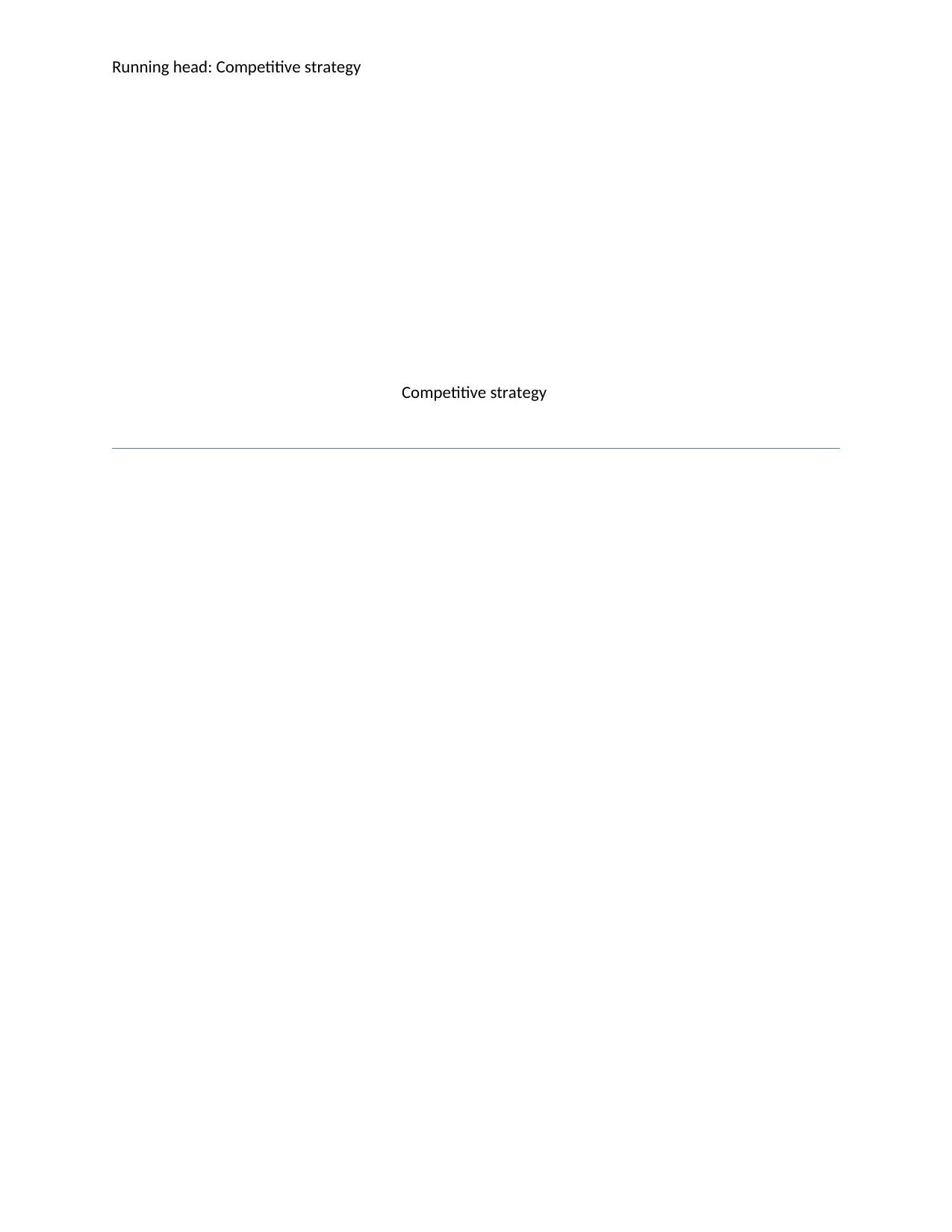
Running head: Competitive strategy
Competitive strategy
Competitive strategy
Paraphrase This Document
Need a fresh take? Get an instant paraphrase of this document with our AI Paraphraser
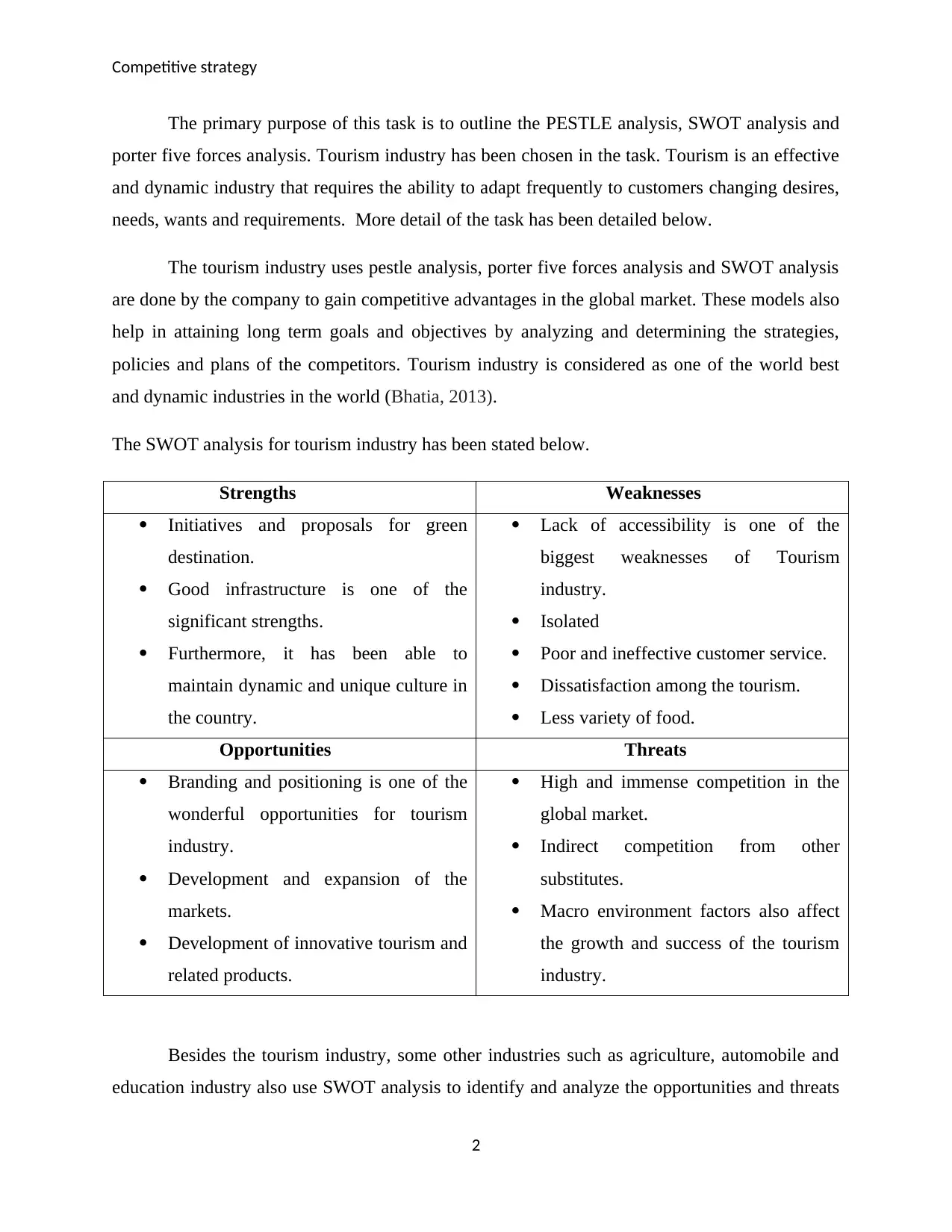
Competitive strategy
The primary purpose of this task is to outline the PESTLE analysis, SWOT analysis and
porter five forces analysis. Tourism industry has been chosen in the task. Tourism is an effective
and dynamic industry that requires the ability to adapt frequently to customers changing desires,
needs, wants and requirements. More detail of the task has been detailed below.
The tourism industry uses pestle analysis, porter five forces analysis and SWOT analysis
are done by the company to gain competitive advantages in the global market. These models also
help in attaining long term goals and objectives by analyzing and determining the strategies,
policies and plans of the competitors. Tourism industry is considered as one of the world best
and dynamic industries in the world (Bhatia, 2013).
The SWOT analysis for tourism industry has been stated below.
Strengths Weaknesses
Initiatives and proposals for green
destination.
Good infrastructure is one of the
significant strengths.
Furthermore, it has been able to
maintain dynamic and unique culture in
the country.
Lack of accessibility is one of the
biggest weaknesses of Tourism
industry.
Isolated
Poor and ineffective customer service.
Dissatisfaction among the tourism.
Less variety of food.
Opportunities Threats
Branding and positioning is one of the
wonderful opportunities for tourism
industry.
Development and expansion of the
markets.
Development of innovative tourism and
related products.
High and immense competition in the
global market.
Indirect competition from other
substitutes.
Macro environment factors also affect
the growth and success of the tourism
industry.
Besides the tourism industry, some other industries such as agriculture, automobile and
education industry also use SWOT analysis to identify and analyze the opportunities and threats
2
The primary purpose of this task is to outline the PESTLE analysis, SWOT analysis and
porter five forces analysis. Tourism industry has been chosen in the task. Tourism is an effective
and dynamic industry that requires the ability to adapt frequently to customers changing desires,
needs, wants and requirements. More detail of the task has been detailed below.
The tourism industry uses pestle analysis, porter five forces analysis and SWOT analysis
are done by the company to gain competitive advantages in the global market. These models also
help in attaining long term goals and objectives by analyzing and determining the strategies,
policies and plans of the competitors. Tourism industry is considered as one of the world best
and dynamic industries in the world (Bhatia, 2013).
The SWOT analysis for tourism industry has been stated below.
Strengths Weaknesses
Initiatives and proposals for green
destination.
Good infrastructure is one of the
significant strengths.
Furthermore, it has been able to
maintain dynamic and unique culture in
the country.
Lack of accessibility is one of the
biggest weaknesses of Tourism
industry.
Isolated
Poor and ineffective customer service.
Dissatisfaction among the tourism.
Less variety of food.
Opportunities Threats
Branding and positioning is one of the
wonderful opportunities for tourism
industry.
Development and expansion of the
markets.
Development of innovative tourism and
related products.
High and immense competition in the
global market.
Indirect competition from other
substitutes.
Macro environment factors also affect
the growth and success of the tourism
industry.
Besides the tourism industry, some other industries such as agriculture, automobile and
education industry also use SWOT analysis to identify and analyze the opportunities and threats
2
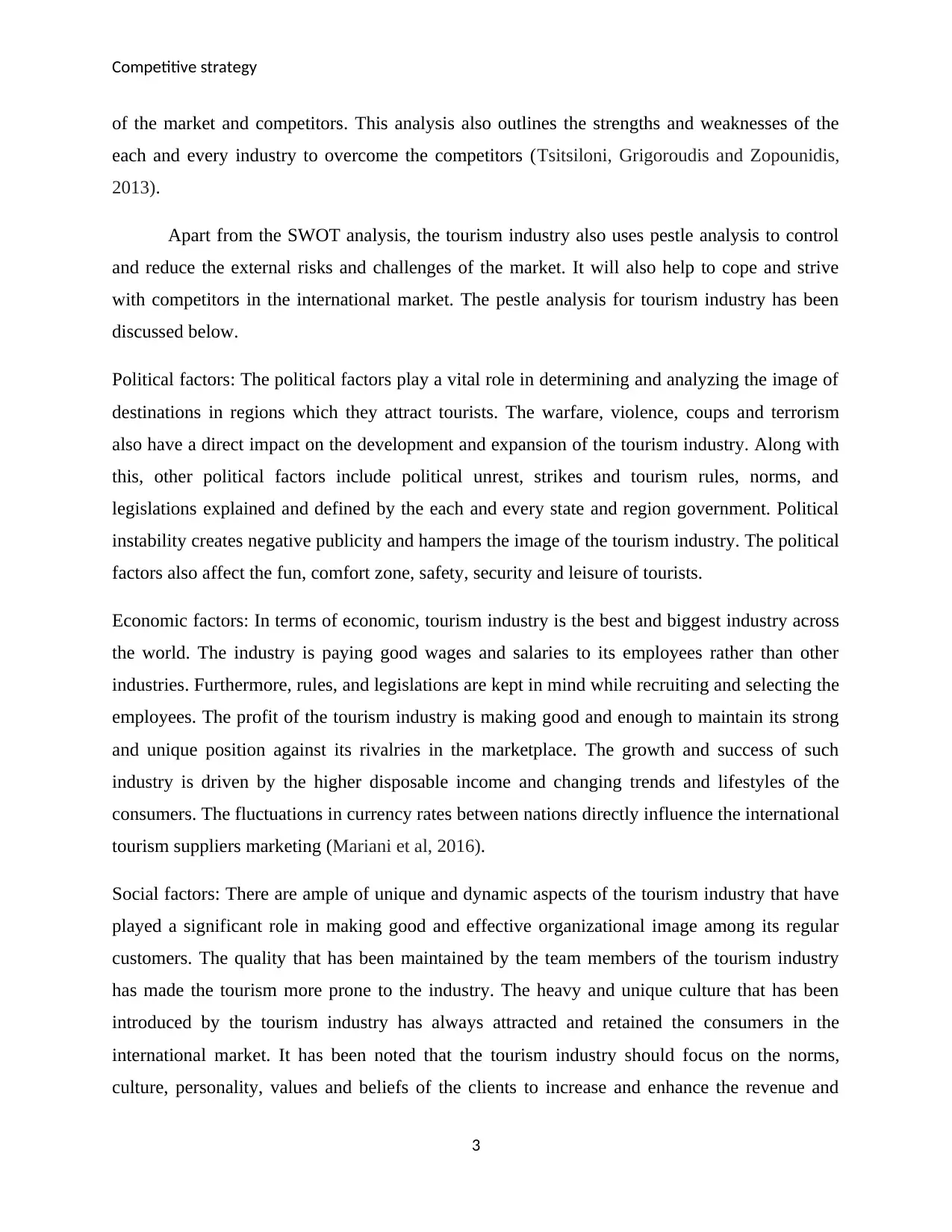
Competitive strategy
of the market and competitors. This analysis also outlines the strengths and weaknesses of the
each and every industry to overcome the competitors (Tsitsiloni, Grigoroudis and Zopounidis,
2013).
Apart from the SWOT analysis, the tourism industry also uses pestle analysis to control
and reduce the external risks and challenges of the market. It will also help to cope and strive
with competitors in the international market. The pestle analysis for tourism industry has been
discussed below.
Political factors: The political factors play a vital role in determining and analyzing the image of
destinations in regions which they attract tourists. The warfare, violence, coups and terrorism
also have a direct impact on the development and expansion of the tourism industry. Along with
this, other political factors include political unrest, strikes and tourism rules, norms, and
legislations explained and defined by the each and every state and region government. Political
instability creates negative publicity and hampers the image of the tourism industry. The political
factors also affect the fun, comfort zone, safety, security and leisure of tourists.
Economic factors: In terms of economic, tourism industry is the best and biggest industry across
the world. The industry is paying good wages and salaries to its employees rather than other
industries. Furthermore, rules, and legislations are kept in mind while recruiting and selecting the
employees. The profit of the tourism industry is making good and enough to maintain its strong
and unique position against its rivalries in the marketplace. The growth and success of such
industry is driven by the higher disposable income and changing trends and lifestyles of the
consumers. The fluctuations in currency rates between nations directly influence the international
tourism suppliers marketing (Mariani et al, 2016).
Social factors: There are ample of unique and dynamic aspects of the tourism industry that have
played a significant role in making good and effective organizational image among its regular
customers. The quality that has been maintained by the team members of the tourism industry
has made the tourism more prone to the industry. The heavy and unique culture that has been
introduced by the tourism industry has always attracted and retained the consumers in the
international market. It has been noted that the tourism industry should focus on the norms,
culture, personality, values and beliefs of the clients to increase and enhance the revenue and
3
of the market and competitors. This analysis also outlines the strengths and weaknesses of the
each and every industry to overcome the competitors (Tsitsiloni, Grigoroudis and Zopounidis,
2013).
Apart from the SWOT analysis, the tourism industry also uses pestle analysis to control
and reduce the external risks and challenges of the market. It will also help to cope and strive
with competitors in the international market. The pestle analysis for tourism industry has been
discussed below.
Political factors: The political factors play a vital role in determining and analyzing the image of
destinations in regions which they attract tourists. The warfare, violence, coups and terrorism
also have a direct impact on the development and expansion of the tourism industry. Along with
this, other political factors include political unrest, strikes and tourism rules, norms, and
legislations explained and defined by the each and every state and region government. Political
instability creates negative publicity and hampers the image of the tourism industry. The political
factors also affect the fun, comfort zone, safety, security and leisure of tourists.
Economic factors: In terms of economic, tourism industry is the best and biggest industry across
the world. The industry is paying good wages and salaries to its employees rather than other
industries. Furthermore, rules, and legislations are kept in mind while recruiting and selecting the
employees. The profit of the tourism industry is making good and enough to maintain its strong
and unique position against its rivalries in the marketplace. The growth and success of such
industry is driven by the higher disposable income and changing trends and lifestyles of the
consumers. The fluctuations in currency rates between nations directly influence the international
tourism suppliers marketing (Mariani et al, 2016).
Social factors: There are ample of unique and dynamic aspects of the tourism industry that have
played a significant role in making good and effective organizational image among its regular
customers. The quality that has been maintained by the team members of the tourism industry
has made the tourism more prone to the industry. The heavy and unique culture that has been
introduced by the tourism industry has always attracted and retained the consumers in the
international market. It has been noted that the tourism industry should focus on the norms,
culture, personality, values and beliefs of the clients to increase and enhance the revenue and
3
⊘ This is a preview!⊘
Do you want full access?
Subscribe today to unlock all pages.

Trusted by 1+ million students worldwide
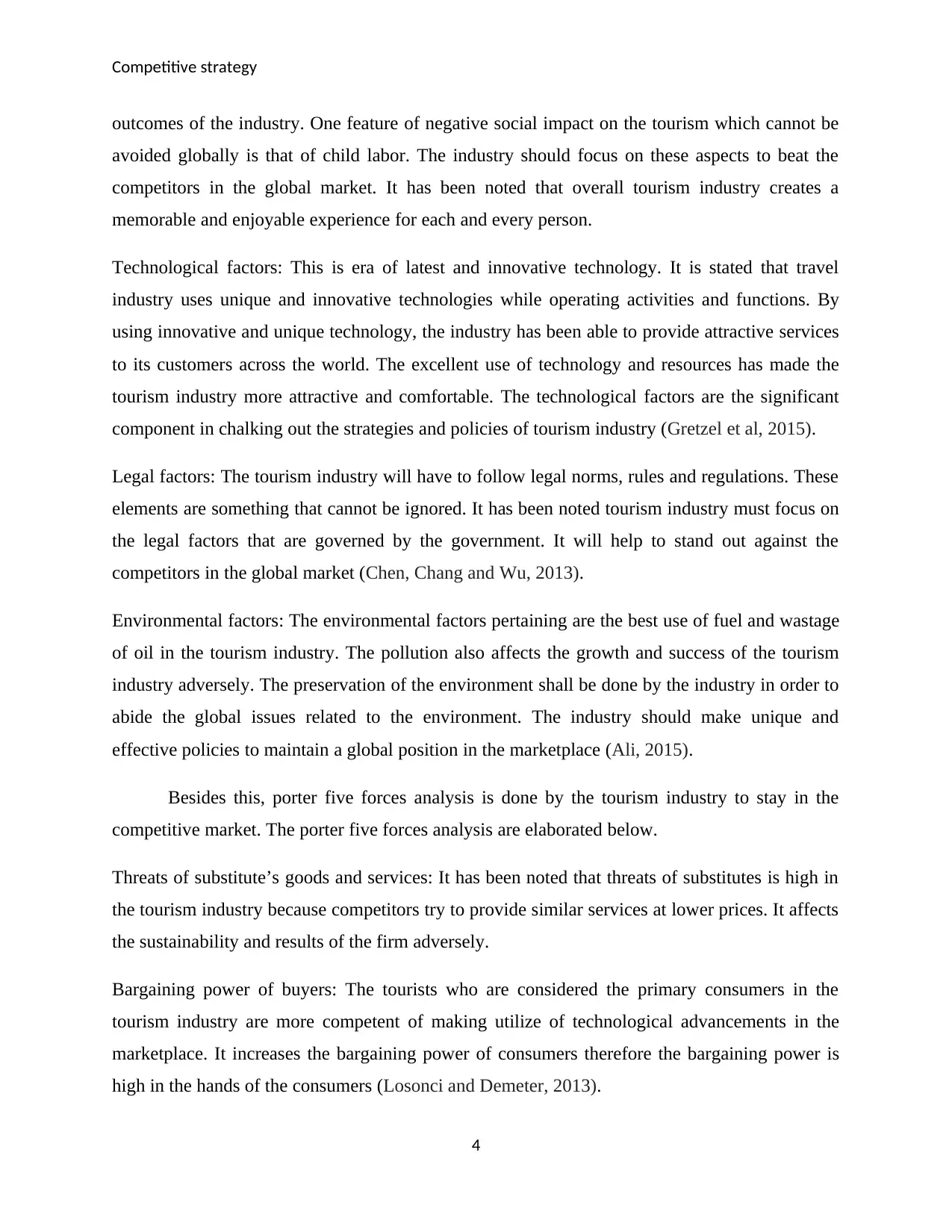
Competitive strategy
outcomes of the industry. One feature of negative social impact on the tourism which cannot be
avoided globally is that of child labor. The industry should focus on these aspects to beat the
competitors in the global market. It has been noted that overall tourism industry creates a
memorable and enjoyable experience for each and every person.
Technological factors: This is era of latest and innovative technology. It is stated that travel
industry uses unique and innovative technologies while operating activities and functions. By
using innovative and unique technology, the industry has been able to provide attractive services
to its customers across the world. The excellent use of technology and resources has made the
tourism industry more attractive and comfortable. The technological factors are the significant
component in chalking out the strategies and policies of tourism industry (Gretzel et al, 2015).
Legal factors: The tourism industry will have to follow legal norms, rules and regulations. These
elements are something that cannot be ignored. It has been noted tourism industry must focus on
the legal factors that are governed by the government. It will help to stand out against the
competitors in the global market (Chen, Chang and Wu, 2013).
Environmental factors: The environmental factors pertaining are the best use of fuel and wastage
of oil in the tourism industry. The pollution also affects the growth and success of the tourism
industry adversely. The preservation of the environment shall be done by the industry in order to
abide the global issues related to the environment. The industry should make unique and
effective policies to maintain a global position in the marketplace (Ali, 2015).
Besides this, porter five forces analysis is done by the tourism industry to stay in the
competitive market. The porter five forces analysis are elaborated below.
Threats of substitute’s goods and services: It has been noted that threats of substitutes is high in
the tourism industry because competitors try to provide similar services at lower prices. It affects
the sustainability and results of the firm adversely.
Bargaining power of buyers: The tourists who are considered the primary consumers in the
tourism industry are more competent of making utilize of technological advancements in the
marketplace. It increases the bargaining power of consumers therefore the bargaining power is
high in the hands of the consumers (Losonci and Demeter, 2013).
4
outcomes of the industry. One feature of negative social impact on the tourism which cannot be
avoided globally is that of child labor. The industry should focus on these aspects to beat the
competitors in the global market. It has been noted that overall tourism industry creates a
memorable and enjoyable experience for each and every person.
Technological factors: This is era of latest and innovative technology. It is stated that travel
industry uses unique and innovative technologies while operating activities and functions. By
using innovative and unique technology, the industry has been able to provide attractive services
to its customers across the world. The excellent use of technology and resources has made the
tourism industry more attractive and comfortable. The technological factors are the significant
component in chalking out the strategies and policies of tourism industry (Gretzel et al, 2015).
Legal factors: The tourism industry will have to follow legal norms, rules and regulations. These
elements are something that cannot be ignored. It has been noted tourism industry must focus on
the legal factors that are governed by the government. It will help to stand out against the
competitors in the global market (Chen, Chang and Wu, 2013).
Environmental factors: The environmental factors pertaining are the best use of fuel and wastage
of oil in the tourism industry. The pollution also affects the growth and success of the tourism
industry adversely. The preservation of the environment shall be done by the industry in order to
abide the global issues related to the environment. The industry should make unique and
effective policies to maintain a global position in the marketplace (Ali, 2015).
Besides this, porter five forces analysis is done by the tourism industry to stay in the
competitive market. The porter five forces analysis are elaborated below.
Threats of substitute’s goods and services: It has been noted that threats of substitutes is high in
the tourism industry because competitors try to provide similar services at lower prices. It affects
the sustainability and results of the firm adversely.
Bargaining power of buyers: The tourists who are considered the primary consumers in the
tourism industry are more competent of making utilize of technological advancements in the
marketplace. It increases the bargaining power of consumers therefore the bargaining power is
high in the hands of the consumers (Losonci and Demeter, 2013).
4
Paraphrase This Document
Need a fresh take? Get an instant paraphrase of this document with our AI Paraphraser
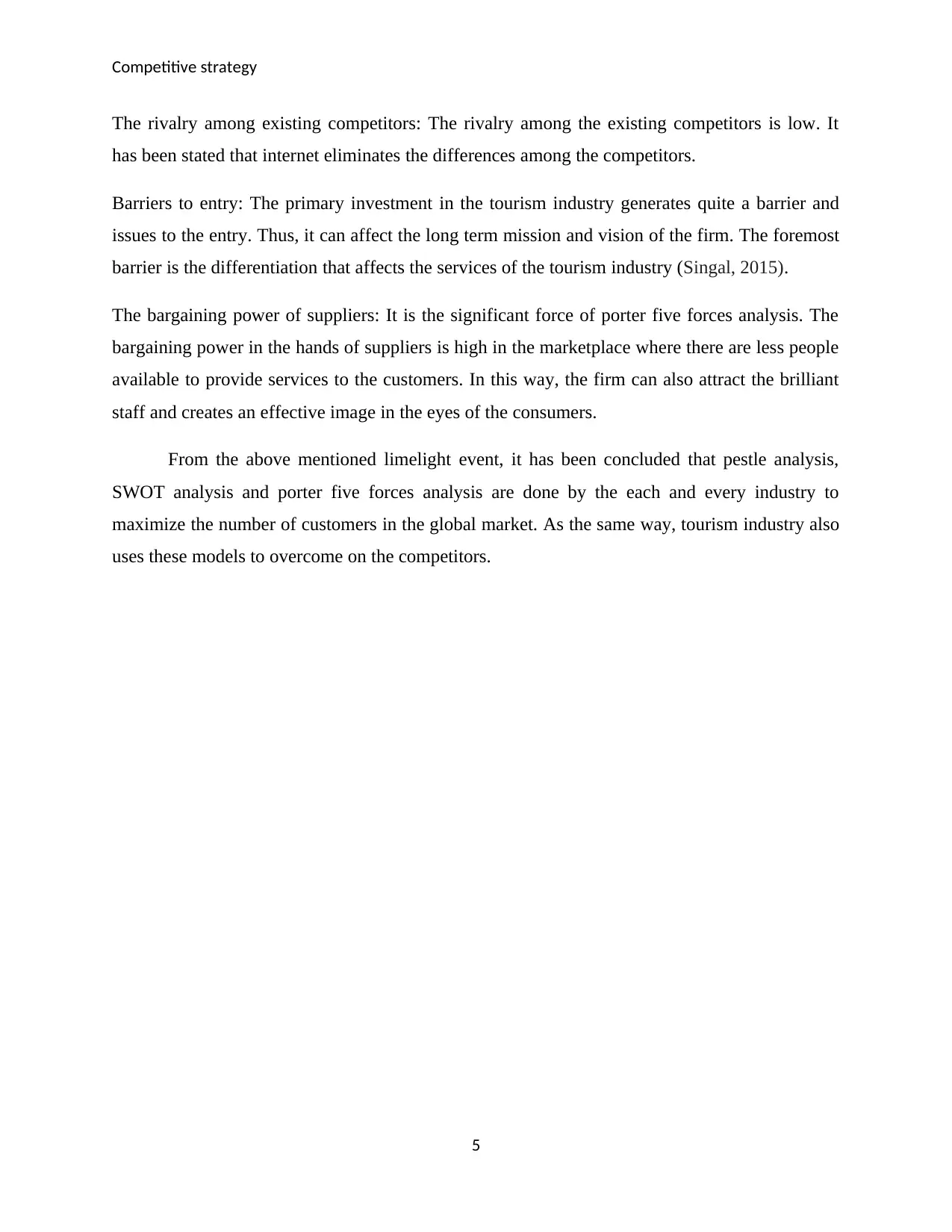
Competitive strategy
The rivalry among existing competitors: The rivalry among the existing competitors is low. It
has been stated that internet eliminates the differences among the competitors.
Barriers to entry: The primary investment in the tourism industry generates quite a barrier and
issues to the entry. Thus, it can affect the long term mission and vision of the firm. The foremost
barrier is the differentiation that affects the services of the tourism industry (Singal, 2015).
The bargaining power of suppliers: It is the significant force of porter five forces analysis. The
bargaining power in the hands of suppliers is high in the marketplace where there are less people
available to provide services to the customers. In this way, the firm can also attract the brilliant
staff and creates an effective image in the eyes of the consumers.
From the above mentioned limelight event, it has been concluded that pestle analysis,
SWOT analysis and porter five forces analysis are done by the each and every industry to
maximize the number of customers in the global market. As the same way, tourism industry also
uses these models to overcome on the competitors.
5
The rivalry among existing competitors: The rivalry among the existing competitors is low. It
has been stated that internet eliminates the differences among the competitors.
Barriers to entry: The primary investment in the tourism industry generates quite a barrier and
issues to the entry. Thus, it can affect the long term mission and vision of the firm. The foremost
barrier is the differentiation that affects the services of the tourism industry (Singal, 2015).
The bargaining power of suppliers: It is the significant force of porter five forces analysis. The
bargaining power in the hands of suppliers is high in the marketplace where there are less people
available to provide services to the customers. In this way, the firm can also attract the brilliant
staff and creates an effective image in the eyes of the consumers.
From the above mentioned limelight event, it has been concluded that pestle analysis,
SWOT analysis and porter five forces analysis are done by the each and every industry to
maximize the number of customers in the global market. As the same way, tourism industry also
uses these models to overcome on the competitors.
5
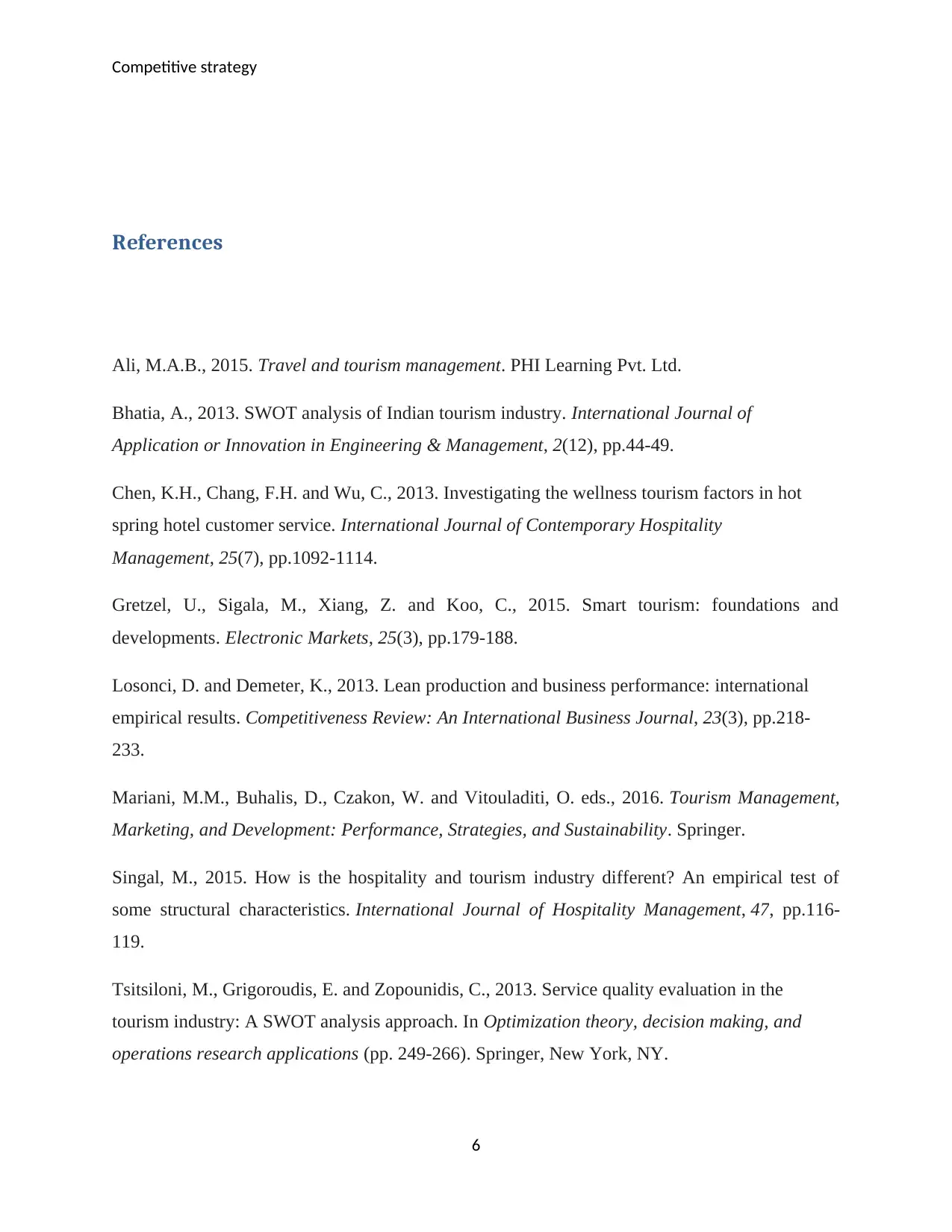
Competitive strategy
References
Ali, M.A.B., 2015. Travel and tourism management. PHI Learning Pvt. Ltd.
Bhatia, A., 2013. SWOT analysis of Indian tourism industry. International Journal of
Application or Innovation in Engineering & Management, 2(12), pp.44-49.
Chen, K.H., Chang, F.H. and Wu, C., 2013. Investigating the wellness tourism factors in hot
spring hotel customer service. International Journal of Contemporary Hospitality
Management, 25(7), pp.1092-1114.
Gretzel, U., Sigala, M., Xiang, Z. and Koo, C., 2015. Smart tourism: foundations and
developments. Electronic Markets, 25(3), pp.179-188.
Losonci, D. and Demeter, K., 2013. Lean production and business performance: international
empirical results. Competitiveness Review: An International Business Journal, 23(3), pp.218-
233.
Mariani, M.M., Buhalis, D., Czakon, W. and Vitouladiti, O. eds., 2016. Tourism Management,
Marketing, and Development: Performance, Strategies, and Sustainability. Springer.
Singal, M., 2015. How is the hospitality and tourism industry different? An empirical test of
some structural characteristics. International Journal of Hospitality Management, 47, pp.116-
119.
Tsitsiloni, M., Grigoroudis, E. and Zopounidis, C., 2013. Service quality evaluation in the
tourism industry: A SWOT analysis approach. In Optimization theory, decision making, and
operations research applications (pp. 249-266). Springer, New York, NY.
6
References
Ali, M.A.B., 2015. Travel and tourism management. PHI Learning Pvt. Ltd.
Bhatia, A., 2013. SWOT analysis of Indian tourism industry. International Journal of
Application or Innovation in Engineering & Management, 2(12), pp.44-49.
Chen, K.H., Chang, F.H. and Wu, C., 2013. Investigating the wellness tourism factors in hot
spring hotel customer service. International Journal of Contemporary Hospitality
Management, 25(7), pp.1092-1114.
Gretzel, U., Sigala, M., Xiang, Z. and Koo, C., 2015. Smart tourism: foundations and
developments. Electronic Markets, 25(3), pp.179-188.
Losonci, D. and Demeter, K., 2013. Lean production and business performance: international
empirical results. Competitiveness Review: An International Business Journal, 23(3), pp.218-
233.
Mariani, M.M., Buhalis, D., Czakon, W. and Vitouladiti, O. eds., 2016. Tourism Management,
Marketing, and Development: Performance, Strategies, and Sustainability. Springer.
Singal, M., 2015. How is the hospitality and tourism industry different? An empirical test of
some structural characteristics. International Journal of Hospitality Management, 47, pp.116-
119.
Tsitsiloni, M., Grigoroudis, E. and Zopounidis, C., 2013. Service quality evaluation in the
tourism industry: A SWOT analysis approach. In Optimization theory, decision making, and
operations research applications (pp. 249-266). Springer, New York, NY.
6
⊘ This is a preview!⊘
Do you want full access?
Subscribe today to unlock all pages.

Trusted by 1+ million students worldwide
1 out of 6
Related Documents
Your All-in-One AI-Powered Toolkit for Academic Success.
+13062052269
info@desklib.com
Available 24*7 on WhatsApp / Email
![[object Object]](/_next/static/media/star-bottom.7253800d.svg)
Unlock your academic potential
Copyright © 2020–2025 A2Z Services. All Rights Reserved. Developed and managed by ZUCOL.




